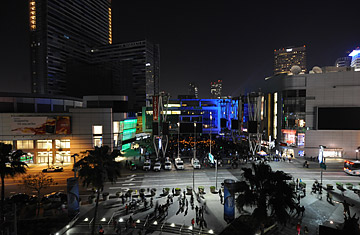
People hold candles in a darkened downtown Los Angeles on March 28, 2009, for a celebration to mark Earth Hour
Los Angeles and New York City are about as different as two cities can be. L.A. is horizontal, while N.Y.C. is vertical. L.A. is about the car; N.Y.C., the subway. And downtown L.A. has traditionally been the laughingstock of the city's nightlife, while N.Y.C. has a concentration of nightlife in Manhattan. Now that is changing. Downtown L.A., which used to be dead after working hours, is striving to become a hub for entertainment, sports, dining and housing, in addition to continuing as a daytime financial center. Some are calling it the "Manhattanization" of downtown.
On a recent Saturday night, there were scenes typical of a happening city center. Hummer limos cruised the streets. Partyers sauntered down sidewalks and joined lines of people waiting to get into nightclubs. Some apparently inebriated clubgoers climbed atop a Denny's sign and waved their arms as a friend snapped an off-balance picture. People exited the Regal Cinemas after showings had finished. The nearby Nokia Theatre prepared to host ESPN's Espy Awards and an American Idol performance that week. Club Nokia, its smaller neighbor, was due to host Boyz II Men and Jamie Foxx in a few days. Looking down on it all was the new 54-story Ritz Carlton tower, which is attached to a J.W. Marriott.
Downtown development took a hit in the recession but is now coming back. Over the past decade, $15 billion in private investment has helped create $40 million in net new tax revenue and 90,000 new jobs, says Jan Perry, city councilwoman for the district. It's the result of a concerted effort by city officials to use tax revenue to make downtown "an area that can be considered alive 24/7 and be a major center for arts, entertainment and culture," Perry says. Residential developers are also looking to downtown because the suburbs of L.A. County have pushed out almost as far as they can go. "Who wants to sit in a car for three hours every day getting to their place of employment from the Inland Empire?" says Dan Fasulo, managing director at Real Capital Analytics, a research firm specializing in the commercial real estate market. "Employers are finding that to attract the best people, they need to locate in places where there's access to multiple forms of transportation. One of those places is city centers."
Nothing reflects the disparity between the new and old downtown like the stimulating L.A. Live district and its aging neighbor, the convention center. The former is a new entertainment nucleus spanning 4 million sq. ft., or six city blocks, which houses bars, restaurants, movie theaters, hotels, live-music venues and Staples Center, the 20,000-seat arena that houses four professional sports teams, including the Lakers. Before Staples, "nobody came downtown," says Michael Roth, spokesman for Anschutz Entertainment Group, which owns the arena and L.A. Live. "It created a destination downtown." The adjacent convention center, however, is a vestige of the past. It is 40 years old and looks it. Its West Hall needs about $50 million in investment to bring it up to date. "Forget about functionality; aesthetics-wise, it's just very odd. It stands out," says Pouria Abbassi, general manager and CEO of the convention center. Its 1971 design is antique "juxtaposed to L.A. Live and Staples Center."
Enter AEG, which owns sports franchises and other large venues, including Miami's American Airlines Arena. It is proposing to build a $1 billion football stadium next to Staples called Farmers Field that would bring an NFL team back to Los Angeles for the first time since the Rams and Raiders skipped town in the 1990s. The plan calls for AEG to build a 68,000-seat stadium where West Hall stands and for the city to sell bonds to afford a new convention-center wing. The field could also be used for large conventions. This week, the company and the city signed a memorandum of understanding to build the stadium, which AEG hopes can open by the 2016 season. AEG says the field would bring even more development and jobs to downtown, and allow the city to host mega-events like the Super Bowl and Final Four. "The greatest economic benefit for the city is through the convention, tourism and hospitality markets," Roth says. The field "will give it the biggest shot in the arm."
It's not just heavyweight AEG investing in downtown. Philanthropist Eli Broad is building a $130 million art museum that is scheduled to open in 2013. The historic Belasco Theater, which lay dormant for 20 years, just reopened after being restored. Developers new to downtown are investing in housing, like the Affirmed Housing Group, which chose the area for its first project in the L.A. market. Officials are even studying a project to build a streetcar system. Portland-based developer Williams & Dame bought a parking lot across from the Ritz Carlton to build a tower that will house a Courtyard by Marriott and Residence Inn. "The dynamics for downtown Los Angeles are terrific for the future," says Homer Williams of Williams & Dame. "You're getting that 24-hour feel that cities need."
Even with the changes, L.A. is unlikely to become another N.Y.C. It still loves its cars and has multiple urban centers stretched out across Southern California, which are unlikely to have their thunder stolen by downtown. And places like Hollywood have gotten their own investment boost in recent years. "We're Los Angeles," Councilwoman Perry says. "There are a lot of unique aspects to what we're doing that are reflective of Los Angeles desires and tastes and interests."
